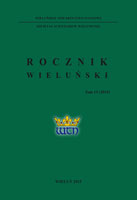Ze studiów nad symboliką samorządową województwa łódzkiego. Herb gminy wiejskiej ze stolicą w Wierzchlesie
From studies on the symbolism of self-government of Lodz province: the coat of arms of a rural community with its capital in Wierzchlas
Author(s): Marek AdamczewskiSubject(s): Cultural history, Local History / Microhistory, Modern Age
Published by: Wieluńskie Towarzystwo Naukowe
Keywords: self-government of Lodz; Wierzchlas
Summary/Abstract: In 2012, after five years of debate on versions of a coat of arms, Wierzchlas Municipal Co- uncil passed a resolution to establish a coat of arms. Councillors accepted that the coat of arms of Wierzchlas would be a shield on a blue background, with an emblem composed of a heraldic lily flanked by two plough wheels. This new emblem, according to its creators, indicates the union’s ownership, connecting villages from the community of Wierzchlas with the Chapter of Gniezno, and the Wierzchlejski family of the Bersten coat of arms. The union of the two towns, Kamion and Toporów, with the Chapter of Gniezno, is certified by a stamp on a document dating from 1532. The face of the stamp was a lily. This, as previously thought, came from the full coat of arms of the Chapter of Gniezno (which features three lilies), and thus confirmed the union of Kamion and Toporów with the Canons of Gniezno. New research on the ownership relations conducted within the municipality of Wierzchlas, as well as further analysis of the stamp of Kamion and Toporów from the year 1532, indicates that the presence of ownership of the Chapter of Gniezno in the municipal area of Wierzchlas can be dated to the first half of the 16th century, and the seal with a lily from 1532 can hypothetically be attributed to the local government of these two towns of Wielun Land. The 2012 version of the coat of arms of Wierzchlas has been positively evaluated by the Heraldic Commission on the grounds of the argument submitted by its creators. Experts were apparently not aware of the work of Tadeusz Nowak on the history of the villages within the municipality of Wierzchlas in the Middle Ages. They also did not notice that the seal of the year 1532, designed as the coat of arms for Kamien Krajenski, was based on the stamp from 1552. So the question remains open as to whether the coat of arms of the municipality of Wierzchlas adequately illustrates the historical traditions of the place.
Journal: Rocznik Wieluński
- Issue Year: 15/2015
- Issue No: 15
- Page Range: 99-116
- Page Count: 18
- Language: Polish

